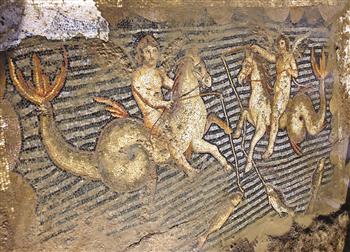To think and feel in the work we do with the horse is to at once declare a center and thus a point of rotation while considering the way that water flows.. The vertical rotation is from above to below or from below to above. The lateral rotation is clockwise or counter-clockwise. Motion and emotion are connected. They are one and the same and in the old ways were connected with water. In waves liquid moves with forces passing through forces. Water fills the container it is placed in. The container which is obvious is the body but the mind too is a container and water fills them both.
In modern dressage most thinking is to consider movement in terms of vectors which are forces set against forces but water does not work that way when it is in a container. When we think in vectors we consider the nature of our own oppositional mind and yet we too can function in waves. Our mind works in vectors but our emotions work in waves. Horses move in waves not vectors but all too often our aides are used as if they are vectors. So it is that modern dressage works through opposition. Vector against vector are forces which we attempt to direct.
Classical dressage works in waves because the horse however prefers the harmony of waves and when the waters become too choppy, one only need to stop and let them settle and then establish simple waves. Follow the current first and use you aids in harmony with the simple waves. This is the key to superior training.
The aides are never fast. Even in rapid movements they are slow and carry the cadence of music. The move quick but slowly never ahead or never behind. There slowness can also be quick but in either case they are gentle and never break the flow. Never dent or try to rupture the container for just like us the first reflex is to protect the container and vectors of force are always a threat.
I realize that perhaps these may be confusing metaphors to some but I hope that some at least will understand. In simple terms only one aid is primary and in classical work it is the hand that works in simple touch; gentle and kind. This is the way of the old masters. The legs were a device to teach the barbarians. The seat can only influence when the hand finds harmonious rule. It is not that one cannot work in other ways but then, it is not truly classical. It is something else then fineness is lost and aggression by need arises. In the end neither horse nor rider is served well but if is the only way one knows then this poor ways is put forward. Few horse and few rider advance well or easily then.
The hand of kindness is the wisdom of the masters and removes doubt and restores confidence to the horse. Lost in this world of speed and aggression but rediscovered when nobility arises in the work. Good dressage, or should it be said, the goodness of dressage is in the flow of the water of kindness in which resistance if found are dissolved.


Recent Comments